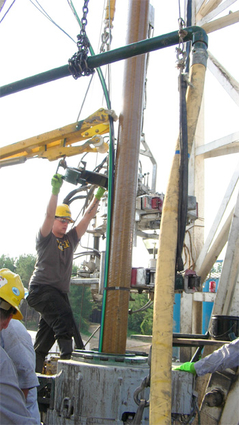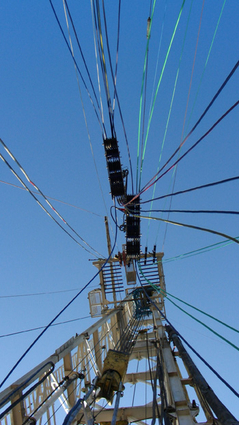Going underground to monitor carbon dioxide
LIVERMORE, Calif. — A technique originally applied to monitor the flow of contaminants into shallow groundwater supplies, has been repurposed to monitor carbon dioxide pumped deep underground for storage.
Electric Resistance Tomography (ERT) has been installed to track where a plume of injected CO 2 moves underground in an oil field (Cranfield Oilfield) near Natchez, Miss. The site is part of the Southeast Regional Carbon Sequestration Partnership (SECARB), a project that eventually will test more than one million tons of CO 2 in underground formations.
The ERT project at Cranfield is the deepest (10,000 feet) subsurface application of the method to date. The previous record of 2,400 feet was held by a European sequestration project near Potsdam, Germany. ERT uses vertical electrode arrays, usually in a cross-well arrangement, to perform four-electrode measurements of changes in the spatial distribution of electrical resistance within a subsurface formation. Because the Cranfield site contains CO 2 , which is five times as resistive as its surroundings, ERT showed that significant resistance changes occurred during plume growth and movement.
"We can image the CO 2 plume as the fluid is injected," said geophys i cist Charles Carrigan, the LLNL lead on the ERT project. "What we’ve seen is a movement of the plume outward from the injection well into the geologic formation used for storage."
ERT, a technology developed for environmental and geologic applications at Livermore starting in the 1980s, is similar to a computed tomography scan. It images soil resistivity, and that gives scientists information on soil properties such as temperature, soil type and saturation. In the case of the Cranfield project, it can provide Carrigan with critical information on what happens to the CO 2 once it’s stored deep underground.
The ERT system was installed in two monitoring wells more than 10,000 feet deep and able to withstand more than 250 degrees Fahrenheit and 5,000 pounds per square inch (psi) of pressure.
SECARB is a partnership led by Southern States Energy Board (SSEB), which is an interstate compact, comprised of governors and state legislators from 16 southern states, Puerto Rico and the U.S. Virgin Islands, as well as a presidential appointee. The sequestration test project is lead by Susan Hovorka of the Bureau of Economic Geology at the University of Texas and is hosted by Denbury Onshore LLC.
Carrigan said monitoring plume characteristics requires sophisticated sensors, data acquisition devices and imaging instruments involving different measurement techniques that are capable of operating in deep boreholes. The results of the monitoring are analyzed to ensure that the site is operating as expected. Even with the proper equipment, plume movement can be difficult to reconstruct due to uncertainties in reservoir structure and unknown multiphase fluid processes.
However, ERT can convert a large number of resistance measurements into an image of electrical resistivity distribution associated with the plume. "Because changes in CO 2 concentration and saturation cause changes in resistivity, ERT is a useful monitoring tool," Carrigan said. ERT monitoring is potentially capable of signaling leakage from a sequestration reservoir possibly years before it can reach an overlying aquifer causing damage to water supplies.
"This is a great start for applying ERT to the very challenging sequestration environment," he said. "We hope we can use ERT in the future at commercial CO 2 underground storage sites."
Other researchers currently involved in the project include Abe Ramirez and Julio Friedmann at Lawrence Livermore and Doug LaBrecque at Multi-Phase Technologies.
The ERT system currently takes 10,000 measurements per day that Carrigan can access remotely. So far the technology has shown that the CO 2 plume produces a strong signal and ERT has captured the basic plume details.
The advantages to power companies looking to store and monitor CO 2 movement and storage underground are very significant, according to Carrigan.
Advantages include: a robust system — no moving parts; outside-the-casing installation leaving the well open for other uses; and relatively low cost to install and continuously operate.
The work was funded by the Department of Energy’s National Energy Technology Laboratory.
Founded in 1952, Lawrence Livermore National Laboratory is a national security laboratory that develops science and engineering technology and provides innovative solutions to our nation’s most important challenges. Lawrence Livermore National Laboratory is managed by Lawrence Livermore National Security, LLC for the U.S. Department of Energy’s National Nuclear Security Administration.
Contact
Anne Stark[email protected]
925-422-9799
Related Links
LLNL receives recovery act funding for carbon capture technologyFunds injected into carbon sequestration effort
Locked in rock: Sequestering carbon dioxide underground
LLNL Energy Research






